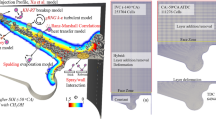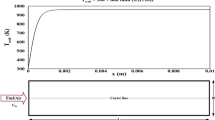Abstract
In the present study, ammonia/air premixed combustion in marine engine relevant conditions has been numerically investigated. Following the potential of ammonia as an alternative carbon-free fuel for engine applications, this work aims to expand the fundamental understanding regarding the ammonia combustion at high pressure and humidity conditions of marine engines. The effects of the mixture equivalence ratio, compression ratio, and particularly the relative humidity on the essential characteristics of ammonia combustion, including laminar flame speed, heat release, and specifically NO emission and the regarding reaction pathways, were extensively investigated at high pressure and temperature relevant to marine engine conditions. The engine’s relevant conditions were simulated by using an isentropic compression step while increasing the temperature and pressure of the mixture to the operating conditions. Then, a one-dimensional flame solver was used to simulate the combustion step. The results show that the laminar flame speed could be decreased by up to 17.5% by increasing the air humidity at every compression ratio, which can lead to stability problems during combustion. However, NO production was mitigated by humid air in fuel-lean conditions. The maximum exhaust NO was decreased by 12% by increasing the relative humidity from 0 to 100%. Nevertheless, the NO reaction pathways did not change with respect to the relative humidity of the mixture, meaning that H2O did not add or change any specific pathway. Combustion efficiency also did not change with the relative humidity.






















Similar content being viewed by others
References
Wolfram C, Shelef O, Gertler P. How will energy demand develop in the develo** world? J Econ Perspect. 2012;26(1):119–38.
Ordoñez J, Gago EJ, Girard A. Processes and technologies for the recycling and recovery of spent lithium-ion batteries. Renew Sustain Energy Rev. 2016;60:195–205.
Chen H, Cong TN, Yang W, Tan C, Li Y, Ding Y. Progress in electrical energy storage system: A critical review. Prog Nat Sci. 2009;19(3):291–312.
Lu X, Geng P, Chen Y. NOx emission reduction technology for marine engine based on tier-III: A review. J Therm Sci. 2020;29(5):1242–68.
Okanishi T, Okura K, Srifa A, Muroyama H, Matsui T, Kishimoto M, et al. Comparative study of ammonia-fueled solid oxide fuel cell systems. Fuel Cells. 2017;17(3):383–90.
Liu H. Ammonia synthesis catalyst 100 years: Practice, enlightenment and challenge. Chin J Catal. 2014;35(10):1619–40.
Eric W. Lemmon, Ian H. Bell, Marcia L. Huber, Mark O. McLinden. Thermophysical properties of fluid systems. In: Linstrom PJ, Mallard WG, editors. N NIST Chemistry WebBook, NIST Standard Reference Database Number 69. National Institute of Standards and Technology, Gaithersburg MD, 20899. https://doi.org/10.18434/T4D303. Retrieved March 7, 2022.
Kobayashi H, Hayakawa A, Somarathne KDKA, Okafor EC. Science and technology of ammonia combustion. Proc Combust Inst. 2019;37(1):109–33.
Ezoji H, Shafaghat R, Jahanian O. Numerical simulation of dimethyl ether/natural gas blend fuel HCCI combustion to investigate the effects of operational parameters on combustion and emissions. J Therm Anal Calorim. 2019;135(3):1775–85.
Sarabi M, Abdi AE. Experimental analysis of in-cylinder combustion characteristics and exhaust gas emissions of gasoline–natural gas dual-fuel combinations in a SI engine. J Therm Anal Calorim. 2020;139(5):3165–78.
Valera-Medina A, Marsh R, Runyon J, Pugh D, Beasley P, Hughes T, et al. Ammonia–methane combustion in tangential swirl burners for gas turbine power generation. Appl Energy. 2017;185:1362–71.
Mørch CS, Bjerre A, Gøttrup MP, Sorenson SC, Schramm J. Ammonia/hydrogen mixtures in an SI-engine: Engine performance and analysis of a proposed fuel system. Fuel. 2011;90(2):854–64.
Liu Y, Zhang J, Ju D, Shi L, Han D. Second-law thermodynamic analysis on non-premixed counterflow methane flames with hydrogen addition. J Therm Anal Calorim. 2020;139(4):2577–83.
**ao H, Valera-Medina A. Chemical kinetic mechanism study on premixed combustion of ammonia/hydrogen fuels for gas turbine use. J Eng Gas Turbines Power. 2017;139(8). https://doi.org/10.1115/1.4035911.
Kurata O, Iki N, Matsunuma T, Inoue T, Tsujimura T, Furutani H, et al. Performances and emission characteristics of NH3–air and NH3CH4–air combustion gas-turbine power generations. Proc Combust Inst. 2017;36(3):3351–9.
Valera-Medina A, Pugh DG, Marsh P, Bulat G, Bowen P. Preliminary study on lean premixed combustion of ammonia-hydrogen for swirling gas turbine combustors. Int J Hydrogen Energy. 2017;42(38):24495–503.
Somarathne KDKA, Hatakeyama S, Hayakawa A, Kobayashi H. Numerical study of a low emission gas turbine like combustor for turbulent ammonia/air premixed swirl flames with a secondary air injection at high pressure. Int J Hydrogen Energy. 2017;42(44):27388–99.
Shi Z, Peng Q, E J, **e B, Wei J, Yin R et al. Mechanism, performance and modification methods for NH3-SCR catalysts: A review. Fuel. 2023;331:125885.
Ye J, E J, Peng Q. Effects of porosity setting and multilayers of diesel particulate filter on the improvement of regeneration performance. Energy. 2023;263:126063.
Liu, R., Ting, D., and Checkel, M., Ammonia as a Fuel for SI Engine. SAE Technical Paper 2003-01-3095, 2003. https://doi.org/10.4271/2003-01-3095.
Ryu K, Zacharakis-Jutz GE, Kong SC. Performance characteristics of compression-ignition engine using high concentration of ammonia mixed with dimethyl ether. Appl Energy. 2014;113:488–99.
Chiong MC, Chong CT, Ng JH, Mashruk S, Chong WWF, Samiran NA, et al. Advancements of combustion technologies in the ammonia-fuelled engines. Energy Convers Manage. 2021;244: 114460.
Koike M, Suzuoki T. In-line adsorption system for reducing cold-start ammonia emissions from engines fueled with ammonia and hydrogen. Int J Hydrogen Energy. 2019;44(60):32271–9.
Guteša Božo M, Mashruk S, Zitouni S, Valera-Medina A. Humidified ammonia/hydrogen RQL combustion in a trigeneration gas turbine cycle. Energy Convers Manage. 2021;227: 113625.
Pirola C, Galli F, Rinaldini CA, Manenti F, Milani M, Montorsi L. Effects of humidified enriched air on combustion and emissions of a diesel engine. Renew Energy. 2020;155:569–77.
Shahpouri S, Houshfar E. Nitrogen oxides reduction and performance enhancement of combustor with direct water injection and humidification of inlet air. Clean Technol Environ Policy. 2019;21(3):667–83.
Ariemma GB, Sabia P, Sorrentino G, Bozza P, de Joannon M, Ragucci R. Influence of water addition on MILD ammonia combustion performances and emissions. Proc Combust Inst. 2021;38(4):5147–54.
Chemical effect of water addition on the ammonia combustion reaction. Thermal Science and Engineering Progress. 2022;32:101318.
CHEMKIN-PRO 15112, Reaction Design: San Diego, 2011.
Dixon-Lewis GN, Cowling TG. Flame structure and flame reaction kinetics II. Transport phenomena in multicomponent systems. Proc Roy Soc Lond Ser A Math Phys Sci. 1968;307(1488):111–35.
Green DW. Perry’s chemical engineers’. Handbook, 7th Edition-Sections. 2008;5–12.
Miller JA, Bowman CT. Mechanism and modeling of nitrogen chemistry in combustion. Prog Energy Combust Sci. 1989;15(4):287–338.
Miller JA, Branch MC, Kee RJ. A chemical kinetic model for the selective reduction of nitric oxide by ammonia. Combust Flame. 1981;43:81–98.
Konnov AA, Ruyck JD. Kinetic modeling of the thermal decomposition of ammonia. Combust Sci Technol. 2000;152(1):23–37.
Mathieu O, Petersen EL. Experimental and modeling study on the high-temperature oxidation of Ammonia and related NOx chemistry. Combust Flame. 2015;162(3):554–70.
Shrestha KP, Seidel L, Zeuch T, Mauss F. Detailed kinetic mechanism for the oxidation of ammonia including the formation and reduction of nitrogen oxides. Energy Fuels. 2018;32(10):10202–17.
Song Y, Hashemi H, Christensen JM, Zou C, Marshall P, Glarborg P. Ammonia oxidation at high pressure and intermediate temperatures. Fuel. 2016;181:358–65.
Tian Z, Zhang L, Li Y, Yuan T, Qi F. An experimental and kinetic modeling study of a premixed nitromethane flame at low pressure. Proc Combust Inst. 2009;32(1):311–8.
Otomo J, Koshi M, Mitsumori T, Iwasaki H, Yamada K. Chemical kinetic modeling of ammonia oxidation with improved reaction mechanism for ammonia/air and ammonia/hydrogen/air combustion. Int J Hydrogen Energy. 2018;43(5):3004–14.
Pfahl UJ, Ross MC, Shepherd JE, Pasamehmetoglu KO, Unal C. Flammability limits, ignition energy, and flame speeds in H2–CH4–NH3–N2O–O2–N2 mixtures. Combust Flame. 2000;123(1):140–58.
Zakaznov VF, Kursheva LA, Fedina ZI. Determination of normal flame velocity and critical diameter of flame extinction in ammonia-air mixture. Combust Explosion Shock Waves. 1978;14(6):710–3.
Hayakawa A, Goto T, Mimoto R, Arakawa Y, Kudo T, Kobayashi H. Laminar burning velocity and Markstein length of ammonia/air premixed flames at various pressures. Fuel. 2015;159:98–106.
Jamrozik A, Grab-Rogaliński K, Tutak W. Hydrogen effects on combustion stability, performance and emission of diesel engine. Int J Hydrogen Energy. 2020;45(38):19936–47.
Zhao L, Wang D, Qi W. Comparative study on air dilution and hydrogen-enriched air dilution employed in a SI engine fueled with iso-butanol-gasoline. Int J Hydrogen Energy. 2020;45(18):10895–905.
Acknowledgements
This work was supported by the National Research Foundation of Korea (NRF) grant, which is funded by the Korean government (MSIT) (No. 2020R1A5A8018822, No. 2021R1C1C2009286). This work was also supported by the Korea Institute of Energy Technology Evaluation and Planning (KETEP) and the Ministry of Trade, Industry & Energy (MOTIE) of the Republic of Korea (No. 20223030040120).
Author information
Authors and Affiliations
Corresponding authors
Additional information
Publisher's Note
Springer Nature remains neutral with regard to jurisdictional claims in published maps and institutional affiliations.
Rights and permissions
Springer Nature or its licensor (e.g. a society or other partner) holds exclusive rights to this article under a publishing agreement with the author(s) or other rightsholder(s); author self-archiving of the accepted manuscript version of this article is solely governed by the terms of such publishing agreement and applicable law.
About this article
Cite this article
Maab, M.P.G., Bathaei, S., Kim, M. et al. Effect of air humidity on premixed combustion of ammonia/air under engine relevant conditions: numerical investigation. J Therm Anal Calorim 148, 8347–8364 (2023). https://doi.org/10.1007/s10973-022-11883-7
Received:
Accepted:
Published:
Issue Date:
DOI: https://doi.org/10.1007/s10973-022-11883-7




